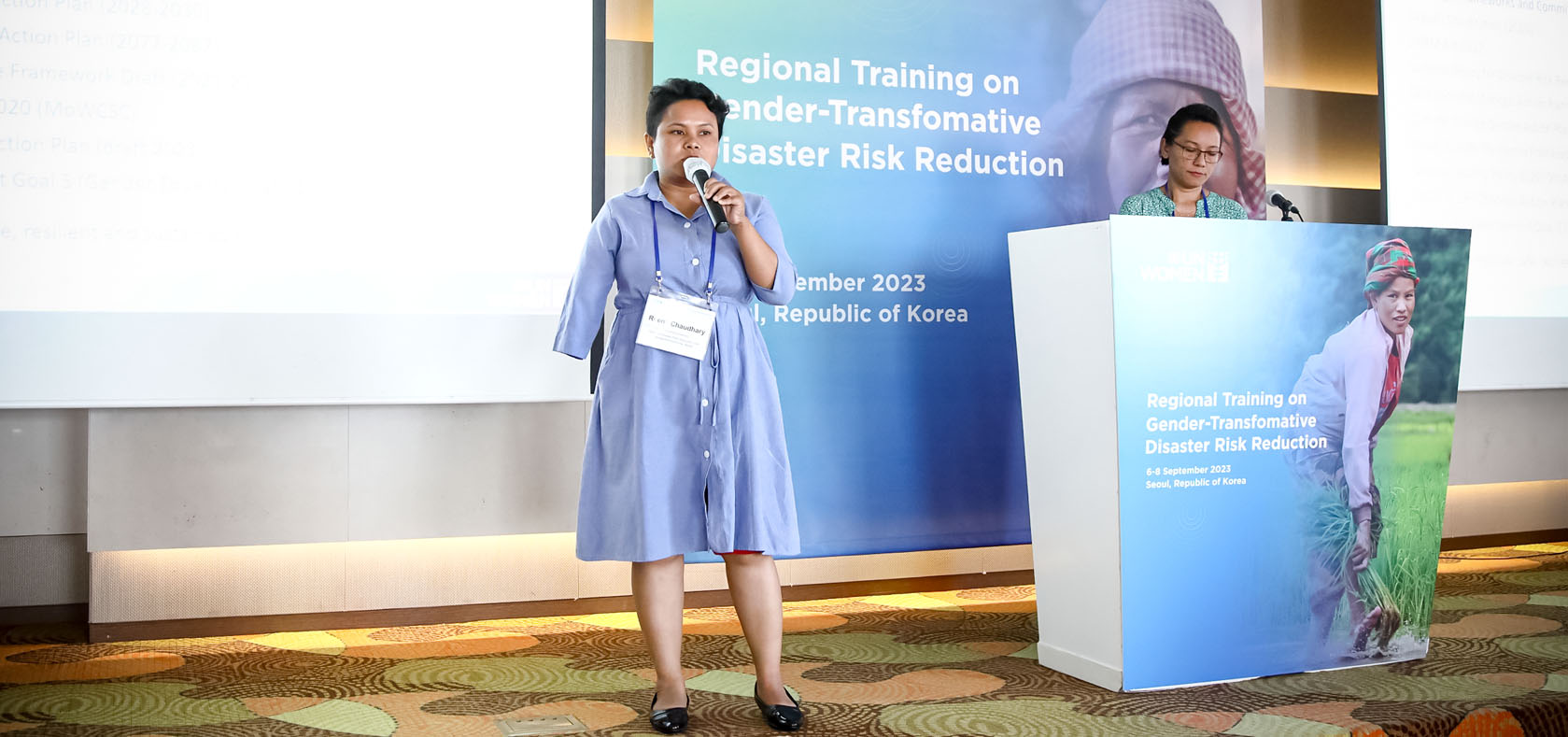Take Five: “We should not see women just as victims of disasters. They are also active agents of change.”
Date:
Interviewed by: Trisha Albay
Reena Chaudhary is the Gender Equality, Disability and Social Inclusion (GEDSI) Focal Person at the National Disaster Risk Reduction and Management Authority (NDRRMA) at the Ministry of Home Affairs in Nepal. Chaudhary participated in UN Women’s Regional Training on Gender-Transformative Disaster Risk Reduction in the Republic of Korea, where she shared her country’s innovative approaches to building the resilience of women and other marginalized groups during disasters.

What are the challenges faced by Nepalese women during disasters?
Nepal is highly vulnerable to various disasters such as floods, landslides, droughts, etc. In fact, it is the tenth most affected country by extreme weather events.
Many young people in Nepal, mostly men, are migrating abroad in search of employment opportunities. When a disaster occurs, local women are usually the first responders for rescuing children, the elderly and other vulnerable members of the community, and they are the ones to inform local stakeholders, security sectors and emergency teams. This puts women at higher risk of injuries.
Lack of electricity, proper shelter, and remoteness of evacuation centres expose women to greater risks of harassment and violence. Moreover, additional care work during disasters falls on women, affecting their mental and physical health as well as reducing their time to rest or generate income.
However, we should not see women just as victims of disasters. They are also active agents of change.
How is Nepal addressing gender equality and social inclusion in disaster risk reduction?
Being prepared for disasters enhances a community’s ability to respond effectively during a disaster and recover more quickly afterward. Realizing this, the Government of Nepal established the National Disaster Risk Reduction and Management Authority (NDRRMA), dedicated to supporting federal, provincial and local governments in disaster preparedness, response and recovery.
Marginalized groups, such as women, LGBTQIA+ people and persons with disabilities, are more severely impacted by disasters, so our response should not be a one-size-fits-all approach. This is why NDRRMA is now drafting the Gender Equality, Disability and Social Inclusion (GEDSI) in Disaster Risk Reduction and Management (DRRM) Strategic Action Plan to ensure they are not left behind.
What are some of the positive aspects of the GEDSI approach in the DRR Strategic Action Plan, and how do you plan to implement it?
One of the positive aspects of Nepal’s GEDSI in the DRRM Strategic Action Plan is that it is based on the four priority actions under the Sendai Framework for Disaster Risk Reduction.
The Plan also adopts intersectionality. Its activities consider the needs, concerns and priorities of vulnerable groups, including women, children, youth, elderly, persons with disabilities and LGBTQIA+ people – from disaster preparedness to response and recovery.
It will soon be endorsed by the Executive Council. Once endorsed, it will be implemented by NDRRMA with the coordination and support of different line ministries, including the Ministry of Home Affairs, the Ministry of Finance and the Ministry of Women, Children and Senior Citizens.
How are you integrating this inclusive approach into your DRR policies, plans and implementation?
Local women, especially those in remote and vulnerable areas, are the first responders in disasters. We see their invaluable knowledge from their direct experiences with past disasters essential in our DRR policymaking and planning. We make sure to include them in disaster risk assessment, which is the basis for our strategy. We need to make sure that we have good funds to implement this.
Additionally, our focus is on building their capacities, promoting gender-responsive policies and encouraging active participation in community-level disaster preparedness activities, ensuring their voices are heard and integrated into our DRR plans.
In your opinion, what challenges remain in ensuring inclusive disaster risk reduction in Nepal?
Although we conduct consultations with local communities, we might still be missing the voices of other marginalized groups. For instance, among women, there are different subgroups who have specific needs and concerns – single mothers, pregnant women, indigenous women, Dalit women, women with disabilities, sexual and gender-based violence survivors, economically poor women, women living in farthest and fragile locations, etc. Are we hearing their voices? Are the persons with disabilities who are invisible in the community able to join consultations? Are people working in the mountains and remote areas able to receive our early warning messages? Are people with a different dominant language able to communicate their thoughts during data collection?
The challenge is to ensure that we are not leaving anyone behind and bring them to decision-making during planning, monitoring, and financing, as well as in other processes.